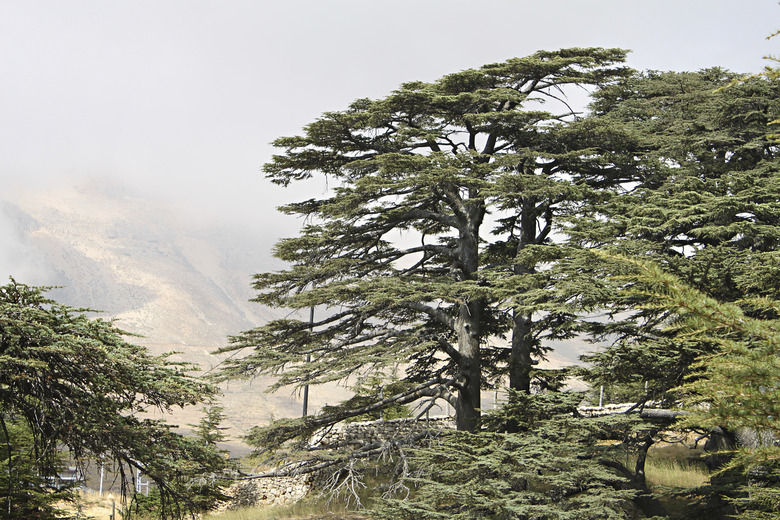What Do Cedar Tree Seeds Look Like?
The true cedars (Cedrus spp.) include four conifer species with rosettes of dark-green to blue-tinged needles, 2 to 4-inch-long, banana-shaped pollen cones and 1/2-inch-long, egg-shaped female "flowers" that develop into 2- to 5-inch-long egg or barrel-shaped seed cones. In the wild, the mature trees range in height from 60 to 200 feet, though prostrate cultivars derived from them may grow no taller than 1 1/2 feet. The cedars' ripe seeds are roughly triangular and white, up to 3/5 inch long and 1/4 inch wide and have broad wings that help them disperse on wind.
Distinguish True Cedars from False Cedars
The four varieties of true cedars are the 60-foot-tall Cyprus cedar (Cedrus brevifolia), the 100-foot Atlas cedar (Cedrus atlantica) native to Africa's Atlas Mountains, the 120-foot cedar of Lebanon (Cedrus libani) and the 200-foot deodar cedar (Cedrus deodara) from the Himalayas. Deodar cedar is hardy in U.S. Department of Agriculture plant hardiness zones 7 through 10, and the other three species are hardy in USDA zones 6 through 9. Several other kinds of evergreen trees often are called cedars, and they include arborvitae (Thuja spp., USDA zones 4 through 10), false cypress or white cedar (Chamaecyparis spp., USDA zones 4 through 11) and incense cedar (Calocedrus spp., USDA zones 5 through 9). Because they aren't true cedars, however, information about true cedars' seeds may not apply to them.
Harvest the Seeds
True cedars' seeds generally ripen in September and October. Harvest the cones before they open because their opening disperses their seeds. After twisting those cones to separate them from their tree, spread them on a tarp in sunlight and leave them there until their scales relax to reveal the seeds. Two winged seeds usually are at the base of each scale of a cone. You can remove the wings by rubbing the seeds briskly with a dry rag, but wear rubber gloves to avoid getting sticky resin on your fingers. Sowing the seeds immediately is best because too much drying affects their viability, and their resin may cause them to mold during storage. If you can't plant the seeds right away, then keep them in a covered container in a refrigerator until you can plant them.
Prepare the Seeds
Although cedar seeds don't require stratification, they germinate more consistently after they experience a cold period, which doesn't have to be long. They should experience that cool period naturally if you plant them outdoors in autumn immediately after soaking them in water for 24 hours. Seeds refrigerated until spring planting also will have experienced sufficient chilling. If you plan to plant purchased seeds outdoors during the summer months, then refrigerate them for two weeks before sowing if they are Atlas or deodar cedar seeds, and refrigerate them for one month before sowing if they are Cyprus cedar or cedar of Lebanon seeds.
Sow the Seeds
The outdoor location for your cedar seeds should have sandy loam. Because conifer seedlings grow best in partial shade when young, plant them in a site that receives direct sunlight only part of each day, or shield the site with lath, lattice or a snow fence laid horizontally over supports after the seedlings emerge from the soil. After loosening the soil in the chosen area to a depth of 1 foot, sow Atlas cedar seeds 1/4 inch deep, cedar of Lebanon and Cyprus cedar seeds 1/2 inch deep and deodar cedar seeds 3/4 inch deep. Space the seeds 4 to 6 inches apart. They may begin to germinate within two to three weeks, or they may not germinate until spring. If your climate has cold winters, then mulch the seedbed or seedlings with a 3- to 4-inch-thick layer of straw or dead leaves after autumn's first hard frost.
References
- The Woody Plant Seed Manual; F.T. Bonner and Robert P. Karrfalt
- University of Wisconsin Cooperative Extension: Collecting and Planting Seeds of Cone-Bearing Trees
- Oregon State University: Common Trees of the Pacific Northwest — False Cedars (Calocedrus, Thuja, Chamaecyparis)
- Woody Plant Seed Manual; U.S. Department of Agriculture, Forest Service
- Dictionary of Biblical Imagery; Leland Ryken et al., Editors
- The Telegraph: Growing Trees and Shrubs from Seed
- Iowa State University Extension, Forestry Extension Notes: Growing Seedlings from Seed
- The New Sunset Western Garden Book; Kathleen Norris Brenzel, Editor
- The Plant Book; Susan Page and Margaret Olds, Editors
